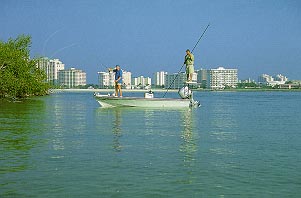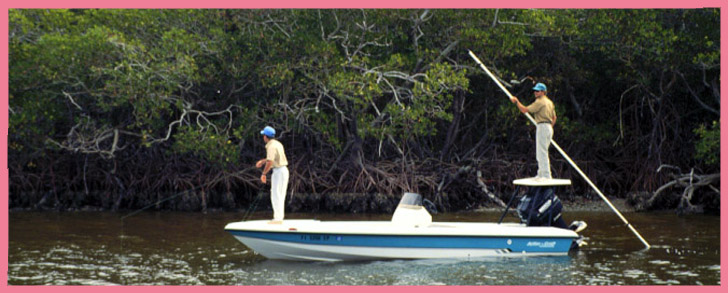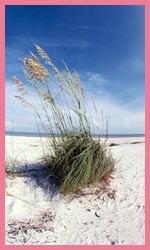|
Marco Island, Florida
Five-Star Resort or Remote Fly Fishing Paradise?
The following was originally published in the November/December 1997 issue of Fly Fishing in Salt Waters magazine. It is
reprinted here with the permission of the author.
©1997, Don Phillips
We fly fishers go through a familiar scene each year. It's time to plan for next year's vacation. You are thinking about
remote places with sparkling water and cooperative fish. Your significant other is dreaming about white sand beaches,
endless boutiques and gourmet restaurants. And of course your teenagers want to swim, in-line skate and establish contacts
with the opposite sex. An irreconcilable dilemma? Not necessarily. Check out my home town, Marco Island, Florida.

Aerial View of Marco Island
Nestled in the mangrove islands of southwest Florida's coast, Marco Island is indeed a world-class resort destination
surrounded by miles and miles of pristine, uninhabited islands, bays, creeks, and the Gulf of Mexico. To the north is the
Rookery Bay National Estuarine Research Reserve and its Briggs Memorial Nature Center. To the south lies the sprawling
10,000 Islands with over 70 coastal miles of fly fishing heaven, inhabited only by the tiny fishing villages of Goodland,
Everglades City, Chokoloskee and eventually Flamingo. Included in this southerly stretch is Collier-Seminole State Park,
the 10,000 Islands National Wildlife Refuge, Fakahatchee Strand State Preserve, Big Cypress National Preserve and the
5000 square mile Everglades National Park, ensuring continued protection against coastal development.
Four miles wide by six miles long, Marco Island is home to about 14,000 year-round residents. During the months of
January through March however, the island population swells to well over 30,000 due to the annual influx of vacationers
and winter residents, filling up the large inventory of hotel rooms, condos, villas and apartments. No wonder, with our
dependable sunshine and winter afternoon temperatures usually in the 70's and 80's.
Gulf water temperatures range from the low 60's in the winter to the high 80's in the summer and fall, providing good fly
fishing during the winter and outstanding fly fishing during the spring summer and fall. The principal species available to
the backwater fly fisher are snook, redfish, tarpon, jack crevalle, seatrout, ladyfish, spanish mackerel, pompano and
mangrove snapper. If you don't mind going a bit offshore and using different fishing techniques, there are also
opportunities for cobia, tripletail, king mackerel, barracuda, grouper, snapper, amberjack, drum, shark, permit and many
other species. Fortunately, most anglers do go offshore and so the backwaters are usually free from crowding, even during
the busy winter season.
Imagine being only a mile or two from your hotel or condo and enjoying quality fly fishing with no one else in sight other
than your guide and perhaps a fishing partner. And you can easily be back in time to shower and then enjoy a good dinner
at one of our 90 top-notch restaurants. Some of my personal favorites are the Island Cafe (French), Cafe de Marco
(Seafood), Conrad's (Beef), the Bavarian Inn (German), Arturo's (Italian), La Casita (Mexican) and Su's Garden (Chinese).
Later, take in the beauty of one of our famous gulf sunsets, go to the movies or enjoy the entertainment available at a local
lounge. And during the day, while you're away fishing, there are about 120 retail shops on the island to get the attention of
your family. Marco Island is one of those special places where world-class tropical fly fishing and all the comforts of home
co-exist side-by-side.
All local guides agree that spring and early summer provides fantastic fly fishing. Capt. Stacy Mullendore, who berths his
19-foot ActionCraft on the island, is especially enthusiastic. According to Stacy, "Late spring and early summer will bring
warmer weather, lighter breezes and a relief from the cold fronts which periodically disrupt local fishing. With rising water
temperatures, massive numbers of baitfish and crustaceans invade the area and of course the snook, tarpon and redfish
gorge themselves on this cornucopia. The tarpon migration is in full swing, the snook are beginning to spawn on the beach
and the redfish are very active feeding on shrimp and crabs. These gamefish and others will be along the beaches, in the
passes and all around the barrier islands, taking advantage of the plentiful food supply."
Another local charter captain who likes the spring and summer fishing, especially for tarpon, is Capt. Andrew Bostick, a
long-time Marco Island resident. Says Andrew, "Marco Island is blessed every year with a migration of large tarpon
between the months of March and August. On their way northward up Florida's west cost, these tarpon enter the creeks and
bays of the Marco Island area to feed and to rest. Sight fishing in the shallow bays for laid-up tarpon in the 100 pound
range can be most exciting! They can also be caught while feeding in the passes. Here, you're casting in the current to
rolling fish, hooking up within a few feet from the surface. The best months for these large tarpon are March through May.
June through August can also produce fish, but the action tends to be more spotty because of the higher water temperatures.
During this latter period, the best time and place is early morning near the beach."
"Baby tarpon, weighing from 2 to 20 pounds, can be found around the island throughout the year. Pound for pound, they
are just as feisty as their larger cousins. Fishing is usually best in the summer. They are most often found in the major
canals, deepwater bays and the remote inland creeks in the mangrove forest. I recommend the safe release of all tarpon;
they have little food value and an artificial replica can be provided by most local taxidermists."
Fishing in the late summer and fall is best in early morning and at dusk, when water surface temperatures are at their lowest.
September and October can produce some outstanding fly fishing for redfish. This is the time when the larger ones will
come out of the Gulf of Mexico and invade the inshore passes and estuaries. A 10-20 pound redfish will put some serious
stress on your fly tackle.

The Author with Guide Capt. Joe Wierback - Photo by Doug Swisher
The winter fishing can be quite good but will require special strategies to locate and tempt the fish. According to Capt. Joe
Wierback, originally from New York State, "Winter is my favorite time of the year for fly fishing. We don't have to get
up in the wee hours of the morning. Instead we concentrate our fishing during mid-day, when the water has warmed up and
the fishes' metabolism is more active. Shallow water, especially those bays and flats which are dark-bottomed, absorb and
retain the sun's rays and warm very quickly under the south Florida sun. The fish come into these shallow areas to warm
up and feed and this can result in some exciting sight fishing."
Winter accommodations can be in short supply because of the high demand. CLICK HERE for help in this regard. Also
make arrangements well in advance for a good guide. It's not unusual for a guide to be fully booked for 2-3 months in
advance.
Night fishing is quite popular on Marco Island, especially for that night denizen, the snook, and the feisty jack crevalle. In
his skiff "Night Flight", Capt. Matt Hoover is often found working at night in the canals and bays of Marco Island. "My
favorite areas are near Caxambas Pass, along the Marco River and along the edges of Smokehouse, Roberts and Collier
Bays", says Matt. "We concentrate on those locations where there is both some form of structure and light sources, the
latter attracting baitfish and letting us see what we're doing. Areas of strong tidal current produce impulse strikes from
snook and jacks, but in calm water they can still often be teased into striking by varying the rate of retrieve. Small glass
minnows imitations are quite productive, especially in white.
"An important part of our night fishing is the need to respect peoples' privacy and property. We are literally fishing in
residents' backyards; we musn't trespass and we have to be quiet so as to not disturb others. Night fishing is soothing, with
the solitude and the sky alive with stars. Fortunately, this solitude is often interrupted by the aggressive strikes of large,
night-feeding fish!"
If you're on a limited budget, there are several ways to help keep your costs down. First, try to come down here in the off-season (May-November), when the fly fishing is at its best and the accommodation rates are at their lowest. You might
wish to consider renting a motel room on the island. The Village Inn is a very nice place with reasonable rates; it has
housekeeping rooms with enough space to comfortably sleep a family of four. Some restaurants, like the Southwest Diner
and the Sand Bar, offer a wide choice of lunch and dinner menus for under ten bucks. Another strategy for keeping costs
down is to stay at one of the dozen or so nearby campgrounds or RV resorts. The campground at Collier-Seminole State
Park is particularly popular with anglers because it is adjacent to the Blackwater River and they rent canoes on-site.
Another way to keep your costs down is to plan for some do-it-yourself fishing. I strongly recommend that you spend at
least your first day with an experienced fly fishing guide, to get a feeling for the species, conditions and tactics. Then
you're in a position to do some effective exploring on your own. You can rent a boat, canoe or kayak from many different
sources on the island. Just use good common sense so as to not get lost nor stranded on a sandbar on a receding tide. The
walking fly fisher can also find success, mainly on the beaches during the spring and summer and along the major canals
adjacent to Routes 41, 29 and 951. Sometimes the canals on the island can be productive, especially when and where there
is significant tidal flow. Marco Island has over 100 miles of inland canals that connect to the Gulf of Mexico or to the
Marco River. And since there are still thousands of unoccupied homesites on Marco, canal access is relatively easy.
For Marco Island fly fishing, a 9-foot, 8-weight rod will meet most of your needs. A 6-weight rod would also be good as a
backup and for those occasions when you are catching mainly ladyfish, small jacks, seatrout, mangrove snapper and spanish
mackerel. Your primary targets will usually be snook, redfish and baby tarpon and the 8-weight outfit is perfect for landing
these 5-20 pound fish. If you will be going after some of our big tarpon in the 60-100+ pound range, then I'd recommend at
least a 12-weight or even up to a 15-weight outfit. Reels should be saltwater-safe, have a good smooth adjustable drag and
an exposed spool rim for palming. The reel should also be large enough to hold a weight-forward line plus 100-200 yards
of 20-pound backing. For large tarpon, 200-250 yards of 30-pound backing would be preferable.
A floating line is appropriate for most of your fishing, though an extra spool or reel with a sink-tip line can sometimes be
useful to get down into deeper channels or holes. Often you can find protected areas to fish where there will be less wind.
Six to nine foot tapered leaders are usually adequate, with a 15-pound tippet strength. An 18-24 inch shock tippet of 30-40
pounds strength is recommended to prevent breakoffs due to abrasion from oyster shells, fish mouths etc. Again, for large
tarpon, scaling up to a 20 pound tippet and a 50-80 pound shock tippet would be recommended. A wire leader is required
for spanish mackerel or barracuda, to prevent breakoffs caused by their razor-sharp teeth.
The prey upon which our gamefish usually feed run the full gamut from tiny glass minnows, to finger-sized mullet and up.
A good selection of flies is recommended, to cover many different fishing situations. Deceivers, Seaducers, Clousers,
Bendbacks, Tarpon Flies, Foam Poppers, Whistlers and Wool-bodied flies all produce at one time or another. The size
range should be from #6 up to 3/0, if you want to cover most situations. For those of you who have Internet access, you
might want to get more detailed suggestions on flies, tackle, tactics, etc., from a 12-chapter series of articles which I wrote
for our local website. The address for these articles is:
www.marco-island-florida.com/don/home.htm .
So, have you decided that I'm high on Marco Island fly fishing? You bet! I was introduced to fly fishing here in 1980, and
in 1989 my wife and I retired here to enjoy both the comforts of resort living and the challenges of fly fishing for large
saltwater fish. The fly fishing at Marco Island has always been quite good, but especially so since the Florida net ban
legislation went into effect in July 1995. Casting guru Capt. Doug Swisher, who guides both in Montana and in Marco
Island's backwaters, is quite excited by the significant increases in marine life. "Snook, redfish, tarpon, seatrout, jacks and
baitfish ---- they're all around in much larger numbers. The fish are not being snagged by the gill nets and, just as
important, they're acting less spooky now that the continual harassment of netting activity has subsided.
"But", Doug continues, "all is not necessarily rosy where the future is concerned. The permanent and vacation populations
of Southwest Florida are growing so fast that additional conservation measures are needed. We need much more restrictive
bag limits to compensate for increasing fishing pressure. All of my clients are fly fishers and we practice only catch-and-release. Hopefully, someday that will be the accepted norm." I guess most of our readers would second that thought. I
know that our future residents and visitors would appreciate the resulting benefits.
Don Phillips
167 Muirfield
Naples, Florida 34113
Phone 239-732-6667
Email tropangler@cyberisle.com
|


